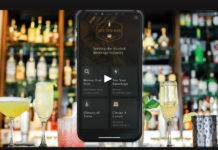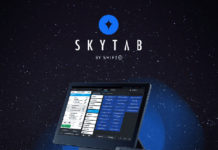Your front door is an entrance and an exit, an ally and an enemy. You want your patrons coming and going safely, and you want trouble permanently on the outs. Here’s how you can secure both.
Everything that happens in your establishment, good or bad, starts at your entrance. The crowd, the vibe, the fights, the falls, the energy, the safety, the comfort, the spontaneity, the scene, the action, and the security—it all hinges upon what goes on at your front door and it trickles down from there. While most bar owners think they have their security under control, and manage their staff with best intentions, even the best of them can slip up now and then.
“It’s hard to pick any particular common mistake bar owners make with their security,” says Anthony Lotito, Founder and CEO of Americore International Security and a retired First Grade Detective of the New York City Police Department. “They’re not so much mistakes as they’re more often exercises in poor judgment.”
IDENTIFY YOURSELF
No one gets in your bar without a valid ID showing them to be 21 years of age or older. That we all know. But just as important as abiding by that law is identifying your establishment as a strict enforcer of it, a notion that can deter underage drinkers from even attempting to enter. New technology for checking IDs not only helps verify various drivers licenses and ID cards, but its very presence can be intimidating to even the gutsiest 20-year-old.
“If a customer walks into a nightclub and sees their picture go up on a computer screen via their driver’s license, even if they’re drunk, in the back of their mind they know how much information you have on them,” explains Andrew Sachs, President of IDScan USA, which is the exclusive distributor for products from U.K.-based IDScan. (www.idscan.co.uk).
For the bar and nightclub scene, Sachs says two new IDscan developments in particular are well suited—a handheld ID scanner available now, and the SCANnet (Safer Clubbing at Night Network) system due out in mid-October.
“SCANnet works by taking a digital image of the front of the ID and uses optical character recognition to extract data,” says Sachs. “We match up the IDs to templates and run them through different algorithms to make sure they are real and valid. Once we get all of that information into the database, we have tons of ways to search that information and use it for security.
“We also have the ability to add a fingerprint scanner to the system, which allows you to register VIPs or members who, the next time they come back, only have to put their finger on the scanner and their information will pop up. We’re also incorporating facial recognition that will use a camera that you can program with the faces of past patrons who have been banned, and it will automatically alert the door staff before they even hand them an ID that this customer is on your no-entry list.”
For bar owners who consider their ID verification system up to par, SCANnet also has a hybrid nature as a marketing tool. “Not only did we keep security in mind when developing SCANnet, we also realized how valuable the gathered ID information is, and we allow users to put this to use for marketing purposes,” says Sachs.
Sachs emphasizes that bar owners should be aware of local regulations regarding personal information and its use, as such laws vary state by state. In that vein, he also suggests bar owners stay aware of their liquor laws and liabilities, as local authorities and governments are always looking for reasons to cite bar owners for underage drinkers and other violations, something that IDscan products can help avoid. “Enforcement of these rules is huge today,” he says. “Especially with the economy the way it is, states are looking to make money, and one of the ways they’re doing that is passing out more citations and penalties to liquor license establishments.”
BALANCING YOUR BOUNCING

“Our system can help bouncers spot fake IDs,” says Sachs of his IDscan technology, “but at the end of day, they still need to look at the person and make sure it’s the right face on the ID. Even with this technology, it’s not fool proof, because some of the forgers have great technology also.”
Your door staff is the next line of defense in keeping the underage out, as well as the troublemakers. Hiring the right mix of doormen, bouncers, and security can be challenging, and requirements for employment can vary from state to state. (For example, in California, any bouncer or security guard has to be registered with the State of California Department of Consumer Affairs Bureau of Security and Investigative Services, complete a criminal background check, including submitting their fingerprints to the California Department of Justice and the Federal Bureau of Investigation, and must undertake the “Skills Training Course for Security Guards” before receiving a security license. In New York State, it is illegal for a bar owner to knowingly hire a felon for a bouncer position, though owners are not required to do background checks on their bouncers.) Let’s face it—Al Capone was a bouncer at one point in his life, evidence that the aforementioned lapses in good judgment also apply to bouncer selection.
“You need guys who know how to talk to people,” says Tony Caldarola, Director of Cabaret Security at Americore International Security and a former New York City police officer. “The stereotype of a bouncer is a guy who is 6’5”, 350 pounds, and can just pound on somebody if necessary. That’s not the right mentality to have. You want to have guys who are articulate, who can talk to people and diffuse a situation. A lot of times, if you talk to people the right way and handle it properly, you can diffuse a situation before fists are thrown. Though you also have to have some sizeable guys so that if a fight does occur you can break it up.”
Having spent a good portion of his post-police career working at clubs like the famous Copacabana in New York, Caldarola knows the security game better than most, from both a law enforcement and club owner perspective. (Caldarola was most recently hired by the Manhattan club Latin Quarter following the now infamous incident in which Giants football star Plaxico Burress shot himself in the leg with his own illegal handgun.)
“If you see someone real rowdy on the line outside who is obviously intoxicated, or big groups of guys like bachelor parties getting drunk, they’re more apt to get involved with something to show off for their friends,” says Caldarola. “Keep them outside.”
“Bar owners should know if all their security guys are registered, and that they’re experienced,” adds Lotito. “It’s also important that the security staff has a good rapport with the owner of the club. We insert a captain who keeps the owner up to date and finds out what he likes and what he doesn’t like, and he relays this back to his team.”
With even-keeled bouncers and other security staff in place, professionalism will go a long way in maintaining peace in your venue. The organization and communication between those team members then becomes crucial.
COMMUNICATION BREAKDOWN
Yes, let’s break it down. Whether you have one bouncer, a manager, and a bartender, or you have 15 bouncers, a cooler, a captain, and four managers on duty, the communication process is vital to your security efforts running smoothly and effectively. In one-room bars, hand signals or whistling can do the trick. But in anything larger, radio devices are highly recommended and very effective.
Custom Earpiece, of Fort Walton Beach, Florida, provides bar and club owners with many options. The BlackDiamond Radio, for example is a great communication tool for security in hotels, nightclubs, and large bars. This handheld device features the most modern compression circuitry available, which means it is an ideal choice for loud venues (as all good clubs will be). The cast aluminum chassis meets military specifications for drop and splash testing, so the rugged nightclub scene won’t take its toll—it will take a beating and keep you in communication with your staff.
For a more discreet security look, Custom Earpiece manufactures the Cipher, a three-wire earpiece communication device. Three wires separate from a strain relief. One wire goes to a discreet clear-coiled tube, which is easily hidden by hair and collar. The second wire goes to a microphone with a clothing pin, and the third wire goes to a discreet “push-to-talk” button.
Using this kind of equipment will keep your staff safer and more confident in its ability to aid each other in any situation, with no communication breakdown.
I SPY
Your staff can vet IDs at the door, maintain order inside the club, and keep each other abreast of all activity. But as the owner, you need to keep an eye on all of that, to not only make sure it’s being done correctly, well, and honestly, but to protect yourself from liability issues whenever possible.
“Not only for security reasons, but for management reasons, video system installations have been a phenomenal investment for the modern club owner,” says Jody Stahl, Director of Business Development for World Wide Security in Garden City, New York (www.worldwidesecurityusa.com). His company designs, installs, and services various security equipment and systems, including CCTV cameras and recording devices for bar and clubs. “We advise bar owners and teach them how to best set up their system. Once we know what they want to achieve, we suggest components, but then also explain what else they can do with the system that is to their advantage.”
Stahl advises bar owners to first consider what they want to capture and where it’s located in their venue. “What do they want to accomplish?” he asks. “Do they want to watch who is coming in the door? Are the bouncers checking the IDs diligently? If you’re going to put a camera up and it’s not going to take a good picture of something, we’ll let them know. If one of their lights is shining right into the camera position they want or need, we’ll let them know it’s not going to work and suggest alternative placement.”
Closed-circuit video systems are accessible via the Internet on a bar owner’s home computer, which not only aids with security, but with liability as well. “If there is an incident in the bar, owners can go back and show it to the police department or other authorities, as well as insurance companies if there was, say, a slip-and-fall,” says Stahl.
After-hours, CCTV installations can also help capture break-ins on film; or vice-versa: Should a loose balloon trip your motion sensors, a club owner can check his cameras from home to see the cause of the alarm before calling the police unnecessarily.
THAT SECURE FEELING
All of this technology and equipment, of course, comes at a cost. “Security can be very expensive,” says Lotito. “But you have to make sure you have a good security force that is also cost-effective. You can’t cut corners.”
An overriding theme to successful security initiatives is the notion of being proactive, rather than reactive, to your club’s environment. From installing the best possible ID scanning equipment, vetting and training your bouncers, utilizing communication technology, and keeping a watchful eye on the whole set-up, club owners have to act first, rather than later. Set the precedent for a proactive approach by your entire staff.
“If you see something starting to brew, groups starting to get verbal, call the police and alert them to just the possibility of an incident,” says Caldarola. “Ask if they can send a car to park in front of the club, just in case. A lot of times, just that presence will prevent a fight from happening outside your club, but a lot of owners don’t want to call the police if an incident hasn’t occurred. But in reality they are just being proactive, trying to stop something before it happens.”
After all, why go through all the effort and all the expense to clean up a mess that didn’t need to be made in the first place?








